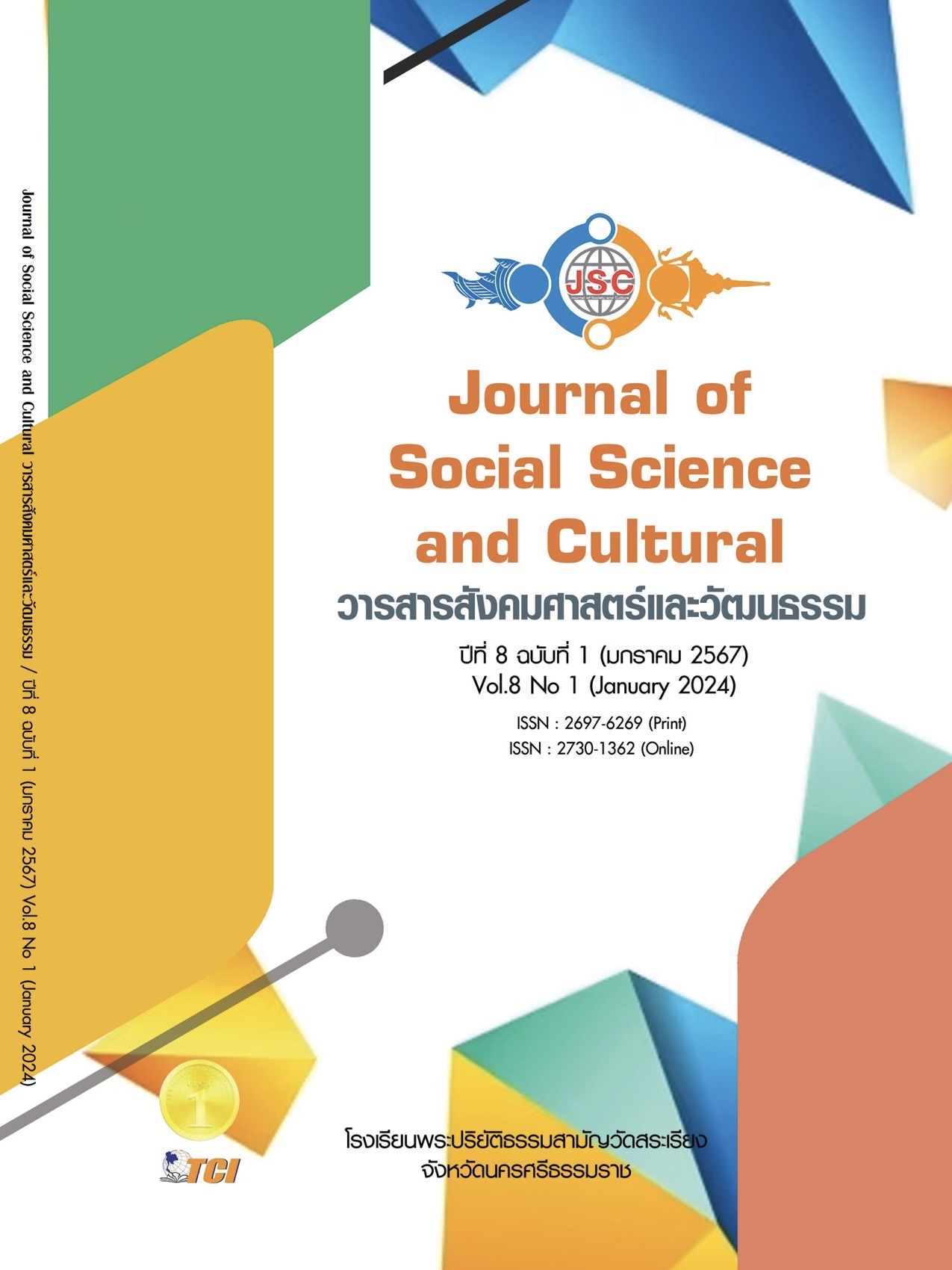NON-BINARY GENDER IDENTITY DEVELOPMENT
Main Article Content
Abstract
This research aims to explore the developmental process of gender identity in non-binary individuals. The study employs a life history research method, involving nine participants selected through snowball and purposive sampling methods. Data were collected through in-depth interviews and observational methods, utilizing semi-structured questions as a research instrument. The data were analyzed using the thematic analysis approach, comprising six steps guided by Braun and Clarke's framework, facilitated by the computer program ATLAS.ti. The findings reveal two themes as follows: 1) the developmental stages of gender identity occur through four phases 1.1) The pre-exploration period including four sub-themes: lack of awareness regarding gender aspects, authentic gender expression before perceiving gender identity, being affected by gender norms, and perceiving gender non-conforming. 1.2) The exploration period includes four sub-themes: gender expression outside normative gender binary, participation in gender-diverse communities, seeking information about gender-related diversity, and gender affirmation. 1.3) Revelation of gender identity period includes two sub-themes: identity disclosure and comprehension of gender identity. 1.4) The gender actualization period encompasses three sub-themes: independence from societal expectations, support for social movements related to gender diversity, and pride in one's identity. (2) The impacts experienced by individuals during their developmental stages, including two highlighted sub-themes: firstly, the impact of social expectations concerning concealing one's authentic gender expression and detaching oneself from society. Secondly, the impact of expressing oneself outside gender binary norms.
Article Details
References
สาวตรี สุขศรี. (2564). การศึกษาการบังคับใช้พระราชบัญญัติความเท่าเทียมระหว่างเพศ พ.ศ. 2558. เพื่อประเมินผลสัมฤทธิ์ของกฎหมาย. กรุงเทพมหานคร: สถาบันพระปกเกล้า.
Bockting, W. O. & Coleman, E. (2016). Developmental stages of the transgender coming out process: Toward an integrated identity. In Principles of Transgender Medicine and Surgery. (2nd ed.) (pp. 137-158). New York and London: Routledge.
Boddington, E. (2016). A qualitative exploration of gender identity in NB young people. In Doctorate in Clinical Psychology. University of East London.
Braun, V. & Clarke, V. (2006). Using thematic analysis in psychology. Qualitative Research in Psychology, 3, 77-101. doi: 10.1191/147/8088706qp063qa.
Bruce, D. et al. (2015). Minority stress, positive identity development, and depressive symptoms: Implications for resilience among sexual minority male youth. Psychology of Sexual Orientation and Gender Diversity, 2(3), 287-296. https://doi.org/10.1037/sgd0000128.
Cass, V. C. (1979). Homosexual identity formation: a theoretical model. J Homosex, 4(3), 219-235. doi:10.1300/J082v04n03_01.
D'Augelli, A. R. (1994). Lesbian and Gay Male Development: Steps Toward an Analysis of Lesbians' and Gay Men's Lives. In Greene, B. & Herek, G. M. (Eds.), Lesbian and gay psychology: Theory, research, and clinical applications (pp. 118-132). Sage.
Devor, A. H. (2004). Witnessing and Mirroring: A Fourteen Stage Model of Transsexual Identity Formation. Journal of Gay & Lesbian Psychotherapy, 8(1-2), 41-67.
Fiani, C. N. & Han, H. J. (2019). Navigating identity: Experiences of binary and non-binary transgender and gender non-conforming (TGNC) adults. Int J Transgend, 20(2-3), 181-194. doi:10.1080/15532739.2018.1426074.
Hegarty, P. et al. (2018). Nonbinary gender identities. ใน N. K. Dess, J. Marecek, & Bell, L. C. (Eds.), Gender, sex, and sexualities: Psychological perspectives (หน้า 53-76). Oxford University Press.
Higa, D. et al. (2014). Negative and Positive Factors Associated With the Well-Being of Lesbian, Gay, Bisexual, Transgender, Queer, and Questioning (LGBTQ) Youth. Youth & society, 46(5), 663-687. https://doi.org/10.1177/0044118X12449630.
Huisman, B. et al. (2021). Psychological Functioning in Non-binary Identifying Adolescents and Adults. Journal of sex & marital therapy, 47(8), 773-784. https://doi.org/10.1080/0092623 X.2021.1950087.
Mahidol University, Plan International, & UNESCO. (2014). Bullying targeting secondary students who are or are perceived to be transgender or same-sex attracted: Types, prevalence, impact, motivation and preventive measures in 5 provinces of Thailand. Bangkok: Mahidol University, Plan International Thailand, UNESCO Bangkok Office.
Meyer, I. H. et al. (2021). Minority stress, distress, and suicide attempts in three cohorts of sexual minority adults: A U.S. probability sample. PloS one, 16(3), e0246827. https://doi.org/10.1 371/journal.pone.0246827.
O’Malley, J. & Holzinger A. (2018). Sexual and gender minorities and the Sustainable Development Goals, United Nations Development Programme.
Perry, J. R. & Green, E. R. (2017). Safe & Respected: Policy, Best Practices & Guidance for Serving Transgender, Gender Expansive, and Non-Binary Children and Youth Involved in the Child Welfare, Detention, and Juvenile Justice Systems. New York City, NY: New York City’s Administration for Children’s Services.
Ryan W. S. et al. (2015). Coming out as lesbian, gay, or bisexual: The lasting impact of initial disclosure experiences. Self Identity, 14, 549–569. doi: 10.1080/15298868.2015.1029516.
Singh, A. A. et al. (2014). “I am my own gender”: Resilience strategies of trans youth. Journal of Counseling & Development, 92, 208-218. https://doi:10.1002/j.1556-6676.2014.00150.x.
Srivastava, A. et al. (2021). Differential Risks for Suicidality and Mental Health Symptoms Among Transgender, Nonbinary, and Cisgender Sexual Minority Youth Accessing Crisis Services. Transgender health, 6(1), 51–56. https://doi.org/10.1089/trgh .2020.00.
Tan, K. K. H. et al. (2020). Gender minority stress: A critical review. Journal of homosexuality, 67(10), 1471–1489. https://doi.org/10.1080/00918369.2019.1591789.
Waagen, A. T. (2022). Non-binary Gender Identity Development: A Qualitative Study. In Doctorate of Philosophy. University of North Dakota.
Wilson, B. D. M. & Meyer, I. H. (2021). Nonbinary LGBTQ Adults in the United States. Los Angeles: The Williams Institute.


